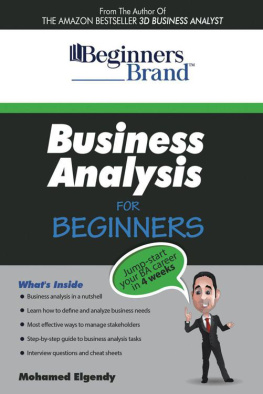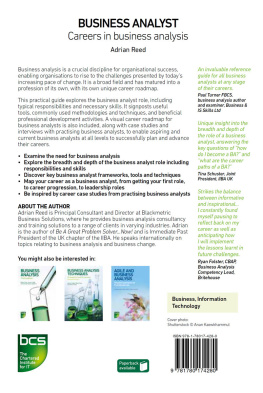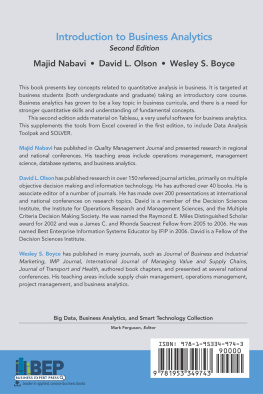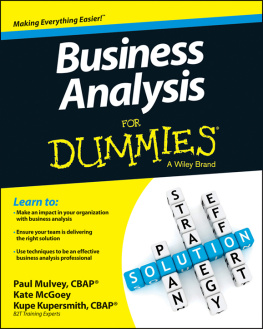The opinions expressed in this manuscript are solely the opinions of the author and do not represent the opinions or thoughts of the publisher. The author has represented and warranted full ownership and/or legal right to publish all the materials in this book.
Business Analysis For Beginners
Jump-Start BA Career in 4 Weeks
All Rights Reserved.
Copyright 2015 Mohamed Elgendy
v1.0
Cover Art 2015 Mohamed Elgendy. All rights reserved used with permission.
This book may not be reproduced, transmitted, or stored in whole or in part by any means, including graphic, electronic, or mechanical without the express written consent of the publisher except in the case of brief quotations embodied in critical articles and reviews.
Outskirts Press, Inc.
http://www.outskirtspress.com
Outskirts Press and the OP logo are trademarks belonging to Outskirts Press, Inc.
PRINTED IN THE UNITED STATES OF AMERICA
I am a great believer in luck, and I find the harder I work, the more I have of it.
~Thomas Jefferson
Business Analysis For Beginners by Beginners Brand
Publishers Acknowledgements
| Proofread by | James Lidington |
| Edited by | Heidi Enright |
| Published by | Outskirts Press |
| Graphic designer | Sreejith U. |
| Special help | Amanda El-Dakhakhni
Karen Colburn-Murphy
Dana Lapnickas
Adriana Corona |
| Trademarks | Beginners Brand is a registered trademark of Elgendy Consulting LLC and may not be used without written permission of the author. |
Warranty Disclaimer:
This book is provided by Elgendy Consulting LLC on an as is and as available basis. Elgendy Consulting makes no representations or warranties of any kind, express or implied, as to the information, content, materials, or products included in this book or available through its website. You expressly agree that your use of and reliance upon this book is at your sole risk. To the maximum extent permitted by applicable law, Elgendy Consulting disclaims all warranties, express or implied, including, but not limited to, implied warranties of merchantability and fitness for a particular purpose, or non-infringement.
Limitation of Liability:
The information, software, products, and services included in this book or available through this its website may include inaccuracies or typographical errors. Changes are periodically added to the information herein. Elgendy Consulting and/or its suppliers may make improvements and/or changes in its website at any time. Advice received in this book and through its website should not be relied upon for personal, medical, legal or financial decisions and you should consult an appropriate professional for specific advice tailored to your situation.
To the maximum extent permitted by applicable law, in no event will Elgendy Consulting, its parent, subsidiaries and affiliates, and the shareholders, officers, directors, employees, and agents of any of them and/or their suppliers be liable for any direct, indirect, punitive, incidental, special, consequential damages or any damages whatsoever including, without limitation, damages for loss of use, data or profits, arising out of or in any way connected with the use or performance of this book or website.
Book Contents
Chapter
Business Analysis in a Nutshell
Business Analysis
In BABOK version 2, the International Institute of Business Analysis (IIBA) defines business analysis, as the set of tasks and techniques used to work as a liaison among stakeholders in order to understand the structure, policies, and operations of an organization, and recommend solutions that enable the organization to achieve its goals.
Translation: Business analysis is the discipline of enabling businesses to identify and meet their goals by determining solutions to business challenges. The goal is to enable companies to determine their objectives for meeting certain opportunities or addressing problems. Solutions often include a system development component, but may also consist of process improvement, organizational change, strategic planning or policy development. The person who executes these tasks is called a Business Analyst or BA.
There is always a business need, our job is to clearly identify, analyze and document this need.
The role of the BA is to work with the Business and IT Teams in developing technology solutions. The International Institute of Business Analysis (IIBA) defines the role as follows:
A business analyst works as a liaison among stakeholders in order to elicit, analyze, communicate, and validate requirements for changes to business processes, policies and information systems. The business analyst understands business problems and opportunities in the context of the requirements and recommends solutions that enable the organization to achieve its goals.
Liaison among stakeholders
The Business Analyst acts as a bridge between business Subject Matter Experts (SMEs) who have a business problem or opportunity and technology people who know how to create solutions for business improvement. You may ask why dont the business SMEs and technology team work together to create solutions? The primary obstacle to this scenario is that the business SMEs tend not to have technical knowledge and the tech nical team tends not to have knowledge of the business processes. You may want to think of the business analyst as a translator who speaks several languages. Without the BA, different team members will not be able to communicate with each other.
Each stakeholder has his or her unique area of knowledge, background, and experience. Often, the differences among the stakeholders are significant, making it not an easy mission for them to communicate with each other. For example, bankers are intimately familiar with the principles, practices, and terminologies involved in the financial business function. IT professionals who will produce and enhance the software systems that the finance people will use are unlikely to have such an understanding. Conversely, the IT people understand the details of how computers work and software is written; bankers are unlikely to share that understanding.
Therefore, the BA is a person who can speak to the users, business people, development team, testers and architects each with their own language to bridge the gap between all stakeholders.
In a nutshell, the business analyst uses tasks and techniques to define and validate solutions that meet business needs, goals and objectives. This solution is defined based on the information gathered from the project stakeholders. In figure 1-1, you can see how project stakeholders (project managers, business SMEs, users, developers, and other stakeholders) throw in their insights on the problem or opportunity to the BA. The BA will then work on analyzing the gathered information to develop a solution that meets their needs and objectives.
Business Analysis Life Cycle









![Yayici - Business analysts mentor book: [with best practice business analysis techniques and sotfware requirements management tips]](/uploads/posts/book/210738/thumbs/yayici-business-analyst-s-mentor-book-with-best.jpg)






